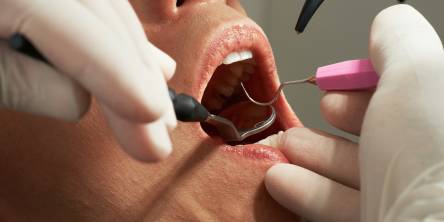Stages of Root Canal Treatment

If you’ve been advised to go for root canal treatment and if this is your first time, you could be nervous. Being informed about what root canal treatment is all about, makes you better prepared and less anxious.
Root canal treatment becomes necessary when the tooth pulp becomes inflamed or infected, leading to severe tooth pain and, eventually, damaging the pulp. Root canal treatment saves the tooth and relieves the pain.
The causes for a root canal could be deep tooth decay, repeated dental procedures on one tooth, trauma such as a crack, chip, or even a root fracture. Sometimes gum disease can also lead to root canal problems necessitating root canal treatment.
Root canal treatment is done in the following steps:
Step 1 – Diagnosis, preparation of the infected site, and rubber dam application - Your dentist will assess the cause for tooth pain after evaluating your medical history and examining the tooth with a radiographic image (X-ray) of the tooth.
Step 2 – Local anesthesia is administered via injections to numb the tooth to be treated and the surrounding tissues. If you are very nervous about the pain, your dentist will use oral sedation to keep you calm during the treatment.
Step 3 – A rubber dam is applied to isolate the infected tooth: This helps the dentist to better access and view the tooth and prevent contamination from the bacteria in the saliva or rest of the mouth.
Step 4 – Accessing the root canal: The root canal is accessed by making a hole in the crown to access the pulp chamber and root canal for treatment. If the back tooth is infected, a hole is made through the biting surface of that affected tooth; if it is the front tooth, the hole is made from behind the tooth to access the pulp chamber.
Step 5 - Cleaning the root canal: The canal is shaped to carry out the disinfection by irrigating the canal. The infected pulp tissue and the damaged nerve are then removed from the root canal. Irrigation of canal disinfects the canal and the pulp chamber with a disinfecting solution.
Step 6 – Shaping the canals: The canals are then shaped with tiny flexible instruments to allow them to receive root canal fillings and sealers.
Step 7 - Sealing the tooth: The cleaned canal is then packed with sealing material called gutta-percha, a biocompatible material. This prevents the entry of microbes and future infections.
Step 8 – Sealing the access hole: A temporary or permanent filling material is placed to seal the access hole (that was made to treat the canals). If the tooth lacks sufficient structure to hold a restoration (filling) in place, a metal post may be placed in one of the canals inside the tooth to help retain it.
Step 9 – Post RCT care: After the procedure, an antibiotic and pain medication may be prescribed to treat or prevent infection and manage pain, if any. Follow the instructions of your dentist or endodontist.
Step 10 – Restoration - Your tooth will need a permanent restoration to replace the lost tooth structure and provide a complete seal to the top of the tooth. The restoration could be a filling or a crown. If you’ve been advised root canal treatment and if this is your first time, you could be apprehensive. Being informed about what root canal treatment is all about, makes you better prepared and less apprehensive.
These are the stages for root canal treatment. If your tooth pulp is infected, then do for root canal treatment. Take the correct medication after the root canal treatment. so that it will cure easily.
Treating root canals require a great deal of precision and care to treat well. Therefore, some of the dentists use state-of-the-art technology including digital (radiographic) imaging to diagnose root canal problems. They use ultrasonic instrumentation to remove old canal fillings and posts and clean canals; and operating microscopes to accurately locate, visualize and seal root canal systems
The whole treatment is quite high-tech and requires highly skilled dentists or endodontists to perform root canal treatment successfully. The dentists who are empathetic and therefore use oral sedation to allay any fear of treatment for the patient.
Similar Articles
Maintaining your oral health is important not only for a bright, confident smile but also for your overall well-being.
The desire for a healthy smile drives approximately 4 million people toward teeth straightening procedures. When it comes to straightening teeth, lingual braces offer a discreet alternative to traditional braces and clear aligners.
As we grow older, our dental needs evolve significantly. The carefree days of childhood tooth fairy visits transform into the more complex world of adult dental care. After age 25, many adults begin to notice changes in their oral health.
Missing teeth can cause a wide range of oral health issues. Nonetheless, over 120 million Americans are missing at least one tooth, and the figure is anticipated to climb as time passes.
A dental emergency doesn’t make an appointment. It shows up unannounced and unapologetic, usually in the middle of the night or during a meal that was supposed to be fun
A dental emergency can strike fast and without warning—during dinner, in the middle of the night, or just before a big meeting.
A wide range of factors can have a direct effect on your oral health. A balanced diet is essential, as is good oral hygiene and regular dental examinations. Many individuals think that nutrition alone can't improve oral health.
The results of wearing Invisalign aligners look stunning, and they are way more convenient than traditional braces. However, no one speaks about what it feels like to wear the same pair of traces around 22 hours a day
Temporomandibular Joint Disorder, commonly known as TMJ, is a condition that causes pain and dysfunction in the jaw joint and surrounding muscles. This disorder can arise from various factors, including teeth grinding, arthritis, jaw injuries, poor posture, or stress.









